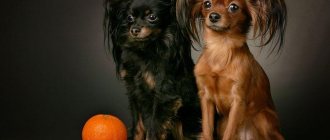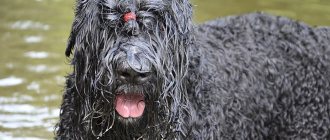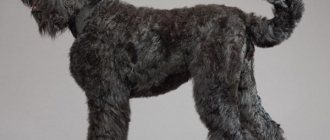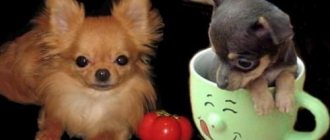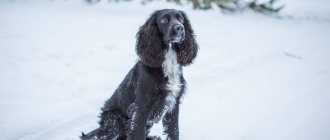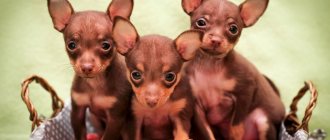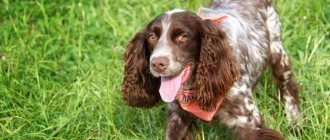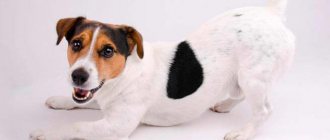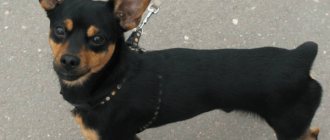Today the breed is called Russian Toy, but for many, the outdated name is more familiar - Russian Toy Terrier. Having gained considerable popularity for its sociable qualities and miniature size, the Toy has become another source of pride for Russian breeders. The fashion for small dogs that can be carried in a bag also played an important role. The Russian Toy has become a rather serious competitor for the Yorkie, since, unlike its “rival”, it has short hair and does not need regular haircuts.
Historical reference
The Russian Toy Terrier dog began to symbolize status and serve as decoration in homes from the beginning of the 19th century. Moreover, the dogs appeared out of nowhere and immediately in large numbers. This development of events can be explained by only one fact - the development of a new breed based on the gene pool of dogs imported into the country from abroad. There is virtually no doubt that the closest ancestor of the Russian Toy is the dwarf Manchester Terrier or English Toy Terrier . In their homeland, these dogs became famous as rat catchers and companions.
The official history of the breed began after revolutions and wars, in the 50s of the 20th century. Cataclysms and political battles destroyed the breed; dozens of purebred dogs remained on the territory of the country, and only a few animals with documents remained. The upcoming difficulties did not frighten Moscow breeders, and they decided to reconstruct the breed. As usual, in practice everything turned out to be even more complicated than in theory; the four-legged animals selected for breeding did not fully correspond to the description of the breed , and sometimes the animals had health problems.
It took breeders 10 years to almost completely recreate the terrier that was once familiar. There was also a nuance - the isolation of livestock specialists and dog handlers of the USSR from colleagues from other countries. The breed continued to be called the English Toy Terrier, despite significant changes in the exterior. Soviet dog handlers were not given any prospects, and they had to intuitively adjust breed standards to the unattainable outside world.
It is easy to guess that dogs of the same breed in Russia and in the West were quite different. The conservation of this situation dragged on for 30 years ; the situation changed dramatically after the fall of the Iron Curtain. Livestock specialists, breeders, dog handlers and simply dog lovers were able to see the results of 30 years of work by foreign colleagues. It was then that it became clear that the large population of miniature dogs already bred in Russia could not bear the name of the English Toy Terrier. Given the fact that the country already had nurseries and its own breed standard, Russian breeders realized that they had almost unintentionally created a new breed that could and should be recognized.
This is interesting! With the fall of the Iron Curtain, foreign dogs began to be imported into Russia, including English Toys and other decorative breeds. Naturally, competition drove some Russian Toy Terriers out of the rings and the market. However, this event cannot be considered as negative for the breed as a whole. After the hype, enthusiastic fans abandoned the factory activities, and true fans continued to groom and cherish their toys.
The consolidation of positive qualities and improvement of the exterior continued, only the breed was already called the Russian Toy Terrier. The breed standard, until 1965, allowed only short-haired dogs , the appearance of long-haired toys is the merit of one person who decided to go against the system. An imperious, fashion-conscious breeder, E. F. Zharova achieved recognition for her long-haired pets almost single-handedly. It all started with the fact that in a litter of breeding toys, a black and tan puppy was born with a defect - feathering on the ears and paws (1958). The baby was so charming that Evgenia decided not only to keep him, but also to consolidate these qualities through selection. The breeder involved her fellow breeders in the work, and by 1965, a group of breeders achieved success - the Russian Longhaired Toy Terrier was officially recognized (in Russia).
After an international exhibition in 2005, where many Toy Terriers were presented, the breed was recognized by the FCI. The decision was made with all rigor and bias, but FCI experts from different countries voted unanimously. After the trials it has experienced, the breed actively stands on its own four paws and develops successfully. Experts diligently eliminate health risks and try to tighten the selection of breeding sires as much as possible. Controlled breeding aimed at improving the breed is carried out in almost all major cities of Russia and abroad - Germany, Belarus, Lithuania and Latvia, Ukraine, Sweden, Estonia, the Czech Republic and other European countries.
History of the breed
The history of the Russian Toy, like the history of most terriers, begins in England and then is divided into two periods. The first is the appearance of the breed in Russia at the end of the 18th century. The second was during the USSR, when the greatest changes occurred with the breed.
It is not known for certain when the first terriers appeared in Russia. But, in the Zoological Museum of St. Petersburg you can see a stuffed English terrier named Lisette, which personally belonged to Peter the Great.
The Russian aristocracy of that time revered English culture. England was a trendsetter, the most developed and progressive country. It is not surprising that everything fashionable in England soon became fashionable in Russia.
The fashion also affected dogs, especially terriers. They were small and fit perfectly into the then fashionable balls, operas and tea parties. Small English toy terriers have become as much an attribute of high society fashion as Chihuahuas are today.
At the beginning of the 20th century, the breed ceased to be rare, but remained prestigious. However, its name changes and they become Russian Toy Terriers. In May 1911, a dog exhibition was held, at which 46 terriers of different breeds were presented. 11 of them were toy terriers.
The events of 1917 dealt a significant blow to the breed. War, famine, devastation and the symbol of the aristocracy could not coexist in one country.
In December 1923, a dog show was held, at which two Russian toy terriers and one English were presented. And after World War II, the breed was practically unknown.
After the war, the demand for large and aggressive dogs increased, and decorative breeds were not popular. Despite the fact that the breed disappeared from official programs, enthusiasts continued to engage in breeding, trying to save their favorite breed from extinction.
They were looking for surviving dogs, many of which were mixed breeds. But there were no other options, since import was simply impossible. Despite these restrictions, fanciers have managed to preserve that unique, true type of dog, which differs from the English type.
Moreover, they managed to get a new type of dog, with long hair. In 1966, a separate standard was created for this type, which became known as the Moscow Longhaired Toy Terrier.
After the fall of the Iron Curtain, Europe learned about this breed, but in its homeland it was under threat. New breeds began to be imported into the country en masse, crossing them with old ones.
In 1988, a new breed standard was adopted, according to which it was divided into two types - smooth-haired and short-haired.
Despite the fact that the history of the breed in its homeland goes back decades, the FCI recognized it only in 2006, and even then with the status of a conditionally (temporarily) recognized breed. This recognition also changed the name of the breed to a shorter one - Russian Toy.
From that moment on, interest in the breed grew significantly; nurseries appeared in Ukraine, Belarus, Estonia, Finland, and the Czech Republic. There is interest among nurseries in the USA and Japan.
Appearance
Small size, good health, stable psyche, unpretentiousness (compared to other miniature breeds) and loyal disposition are the optimal qualities for an apartment companion. Physically, Toy Terriers are weak and thin-boned, but agile, courageous and harmonious in build. Bitches are slightly larger than males (this is a common practice for small dogs), and the restrictions prescribed by the standard are common to both sexes:
- Height 20–28 cm.
- Weight up to 3 kg.
Character and training
A toy, but a real dog - this is how the Toy Terrier describes the breed. In fact, all too often, miniature quadrupeds sit in a bag, trembling and hysterically afraid of the outside world. Mental stability depends on heredity, but upbringing also plays an important role. Initially, the character of Russian Toy Terriers was similar to English Toys - brave, lively, ready for challenges.
Note! In a broad concept, a terrier is a burrowing dog, and in the case of the English toy, a rat catcher. Against the background of the stated characteristics, the four-legged shaking from the rustle looks at least strange.
Photo of a toy terrier
Add "WOOF!" 1
Breed characteristics: | |
| Type |
|
| Size | small (up to 10kg) |
| Main features |
|
| Included in |
|
| Frequent illnesses |
|
| Intelligence | 55% |
| Advertisements for sale of toy terrier Price for toy terrier puppies Reviews How many puppies does the Russian Toy Terrier give birth to? All dog breeds | |
Maintenance and care
The peculiarities of keeping miniature breeds are associated with an increased risk of harm to the pet due to ignorance or carelessness. Caring for the Russian Toy Terrier also includes re-equipping the home for the safety and needs of the tailed one. The minimum measures that an owner should consider before purchasing a puppy:
- in the house higher than 0.4–0.5 meters that the dog can climb on its own.
- Any cracks or cavities behind furniture or appliances must be closed.
- All electrical wires must be hidden under special covers. If a large dog is simply electrocuted when it bites the wire, then the toy can be killed.
- Floor coverings should be covered with non-slip materials, as the dog can slip and dislocate its limbs under its own weight.
- The feeding area must be covered with a non-slip mat.
- The dog's place should be away from heating radiators, drafts, and public areas.
- If there are children in the house , explain to them with all severity and responsibility that clumsiness and carelessness can lead to serious injuries to the pet.
Next, to keep a Toy Terrier you will need clothing - autumn, spring and winter. In regions with particularly cold winters, boots will also be needed. For rainy weather, a waterproof overall is required. Since the fabric of the accessory does not allow water to pass through, it also blocks air circulation, so take off your clothes immediately after a walk. It is also recommended to wipe the pet’s “fur coat” with wet wipes - this will eliminate electrification from friction of the fur on the suit.
In addition to the harness and leash, you will need a convenient carrying bag. Toys are active and love to walk, no less than they love to sit demonstratively in their arms. It only seems in theory that 3 kg is not hard to carry on your arm, but after a 1-2 hour journey, the owner becomes completely sad. A carrying bag will allow you to distribute the load from the “excess weight” over the body and on the spine , in this case, carrying a dog with you is really not difficult.
The dog should not be bathed frequently or scratched intensively (unless it is in the process of shedding). Once a week, the wool is sorted out with a fine-toothed comb. The pet's teeth, ears and eyes should be under constant control. If your dog does not participate in exhibitions, it is recommended to shorten the hair on the ears, hands and groin area.
Feeding
Table feeding is not suitable, as is the case for other dog breeds. It is advisable to use premium and super premium dry food. It is also possible to use a combination of dry and wet food, empirically determining the best option.
With natural feeding, the daily diet should include beef or lamb, boiled chicken or fish fillet. About once a week you can give a boiled egg and offal. Dairy products include kefir and fermented baked milk, while regular milk can cause stomach upset. Porridges made from oatmeal, buckwheat and rice are well consumed. It is better to heat your dog's food. Feed twice a day, after walks. The amount of feed is calculated from the ratio of 50-80 g per 1 kg of animal weight. Young dogs should naturally have more food than older dogs.
Health
The average lifespan of a Russian Toy Terrier ranges from 11 to 16 years, depending on heredity, quality of rearing and care. The breed is characterized as healthy, since in theory, it is characterized by only three diseases:
- Cataracts are a common disease in older dogs. It is expressed by clouding of the lens of the eye. Further development of the clinical picture depends on the general condition of the quadruped. In the worst case scenario, your pet may lose vision or suffer from glaucoma (increased intraocular pressure).
- Retinal atrophy – develops in dogs over 5 years of age. Retinal cells begin to die due to poor blood circulation or deterioration of metabolism. There are no theoretical predictions for the development of the disease, but many dogs live with retinal atrophy without showing any signs. The first symptom is blurred vision in twilight and darkness.
- Congenital medial dislocation of the patella - the quadruped walks on semi-crouched or bent legs. The disease is detected in puppyhood. The relevance of treatment depends on the clinical picture (sometimes the disease cannot be stopped). Even after all the measures have been taken and the kneecap has been restored, the dog has a lifelong tendency to re-injure itself.
We're talking about miniature dogs, which are more prone to injury than their larger counterparts. It is necessary to take care of your ward with all your might and methods from puppyhood. Jumping more than 0.5 meters or falling can cause serious injury. When intentionally jumping from a height, typical injuries include dislocations, sprains of the joints of the front paws, fractures of the forearms, shoulders and metacarpus. Below are a number of diseases that all miniature dogs are prone to:
- Aseptic necrosis of the femoral head (Legg-Calvé-Perthes disease) is a hereditary disease that is not usually classified as a disease, but in practice it is diagnosed quite often. Cells of the femoral head die regardless of the method of maintenance and feeding. Usually, the disease is cured surgically, but the sooner the four-legged dog gets to the veterinarian, the greater the chance of reducing the damage with medication.
- Atlanto-axial instability - most often diagnosed at a young age, caused by displacement of the first cervical vertebra relative to the second (atlas to axis). If the situation is not advanced, the four-legged animal is prescribed to wear a rigid corset, which maintains the correct physiological position of the spine.
- Hydrocephalus is a congenital disorder of the formation of the brain and skull. Simply put, dropsy pressing on the brain. It manifests itself as atypical behavior, loss of balance, deterioration or loss of vision, disorientation, and changes in the shape of the skull.
- Portosystemic anastomosis is a condition where blood not purified by the liver returns to the bloodstream and enters the heart. The disease is caused by an abnormal structure of the liver, or more precisely, an anomaly in its vessels. Health is maintained using conservative methods, but in difficult cases they resort to surgical intervention.
- Cholecystitis in combination with gastritis or as an independent disease - inflammation of the gallbladder.
- Pancreatitis is inflammation of the pancreas.
- Sensitivity to anesthesia and individual intolerance to many medications (antibiotics, analgesics).
